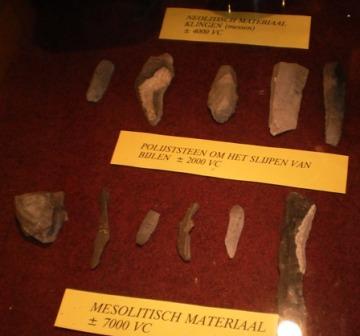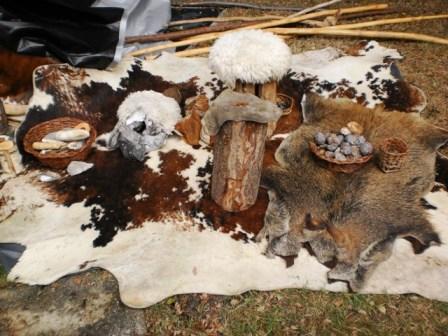Benjamin Schoville and Jayne Wilkins investigated in South Africa arrowheads made sure 500,000 years ago in the Middle Pleistocene by Homo heidelbergensis chinensis.
 Flint is hard (er than steel) (7 on the Mohs scale) and fragile. A fracture has sharp edges. The shards can in order of precision work be knapped (knocked off), chiseled or pressed (pressure flaking). For each treatment, the right angle and power is to be used. Lots of videos circulate on the Internet that show how a flint fabricator of a well-prepared piece of flint with a few strokes can hit many long, razor-sharp shards. Craftsmanship.
Flint is hard (er than steel) (7 on the Mohs scale) and fragile. A fracture has sharp edges. The shards can in order of precision work be knapped (knocked off), chiseled or pressed (pressure flaking). For each treatment, the right angle and power is to be used. Lots of videos circulate on the Internet that show how a flint fabricator of a well-prepared piece of flint with a few strokes can hit many long, razor-sharp shards. Craftsmanship.
Flint occurs as silicic acid (silica or silicon dioxide, SiO2) and is deposited in formation of scale. This silicate has a variety of silicic rock with extremely small crystals. The compact structure gives flint his glass -like appearance and hardness making it shell-shaped breaks when it is beaten. Besides silicate flint contains bound water. This evaporates slowly to air after which the flint is less fissile than 'fresh' specimens which produce considerably longer shards.
Flint can be white, black or gray, or red and green by iron oxides. You can find it as bone –, branch- or antler - shaped tubers. On the outside of these concretions is usually a porous lime zest. The cortex must be removed before processing.
The finest pieces are made with the Levallois technique, named after the site Levallois in Paris. A core stone (or tool stone) is processed till a flat knock off platform (striking platform) arises. Perpendicularly knocking with a hammerstone can produce of the same core few different bars (blades), all more or less the same shape and with very sharp edges. The knapping is done with a stone, a mallet or bone. Specialists apparently prefer antlers.
 The underground mining for the operation of flint in Rijckholt (Dutch Limburg) has probably lasted about 500 years, from 3,950 to 2,650 BC. There was 8.000m3 or 15 million kilo of flint mined, accounting for more than 10 million objects. There have been approximately 2,000 shafts from 4 to 12 m deep and a maximum of 1 m diameter. Because there were no lamps, there was a shaft every 12 m in order to also have sufficient daylight to be able to work. The use of mirrors they did not knew, and fire (which consumes oxygen) they dominated in the first period still insufficient.
The underground mining for the operation of flint in Rijckholt (Dutch Limburg) has probably lasted about 500 years, from 3,950 to 2,650 BC. There was 8.000m3 or 15 million kilo of flint mined, accounting for more than 10 million objects. There have been approximately 2,000 shafts from 4 to 12 m deep and a maximum of 1 m diameter. Because there were no lamps, there was a shaft every 12 m in order to also have sufficient daylight to be able to work. The use of mirrors they did not knew, and fire (which consumes oxygen) they dominated in the first period still insufficient.
Sometimes there was more deeply mined through existing flint layers to a gallery with better quality. So our primitive ancestors had a lot of knowledge.
Also in Valkenburg are flint mines. In Spiennes (in Mons, Belgium) is the oldest and largest complex of flint mines in Europe. The more than 100 -ha site is on the World Heritage List of UNESCO.
In Spiennes prehistoric miners dug through five layers of flint to achieve the 6th of better quality. Around 1913 De Loë even found a shaft that went through 12 layers to reach the 13th for exploitation!
In the Nile Valley (Nazlet Khater 4 and 7) was between 35,000 and 30,000 years BP even at 2 meters mined for flint. In Nazlet Safaha 1 and 2 that would have already happened even between 50,000 and 40,000 years
In 2015, 3.3 million-year-old “Lomekwian tools” were excavated in Kenya: more primitive stones that were used to smash food (nuts) (as some monkeys still do today).
In the Afar region in northeastern Ethiopia, between 2.58 and 2.55 million-year-old “Oldowan tools” were found in a systematic production of stone tools with smaller stones with sharp edges.
Tel Aviv University studied small pieces of flint (between 300,000 and 500,000 years old) in Revadim, Israel for three years. They were created when making larger tools. 107 of the 283 microscopic examined flakes showed traces of wear and the processing of animal carcasses. Organic and inorganic residues were effectively found on 11 of them. These flakes were not waste, but handy and easy-to-take sharp little tools.
In Switzerland is a prehistoric flint ax found at which the stone is mounted in a holder of antlers, which then was back in a wooden handle fixed. Possibly because antler both is robust and shock- absorbent, so that the stone is much less likely to break. The genius of this specimen is that the holder of antler shape is square, like the hole in the stem. As a result, the tool can be mounted in two positions in the handle, and it is usable as a chopper (leaf in the direction of the stem), and as a drawbar (tiller or hoe, leaf at right angles to the stem).
Thumb our ancestors were certainly not.
As glue to mount stone axes or points used our primitive ancestors birch pitch or a mixture of resin, charcoal and grease.
If you strike flint against iron or pyrite you get (hot) sparks. It was also used in muskets (old rifles).
